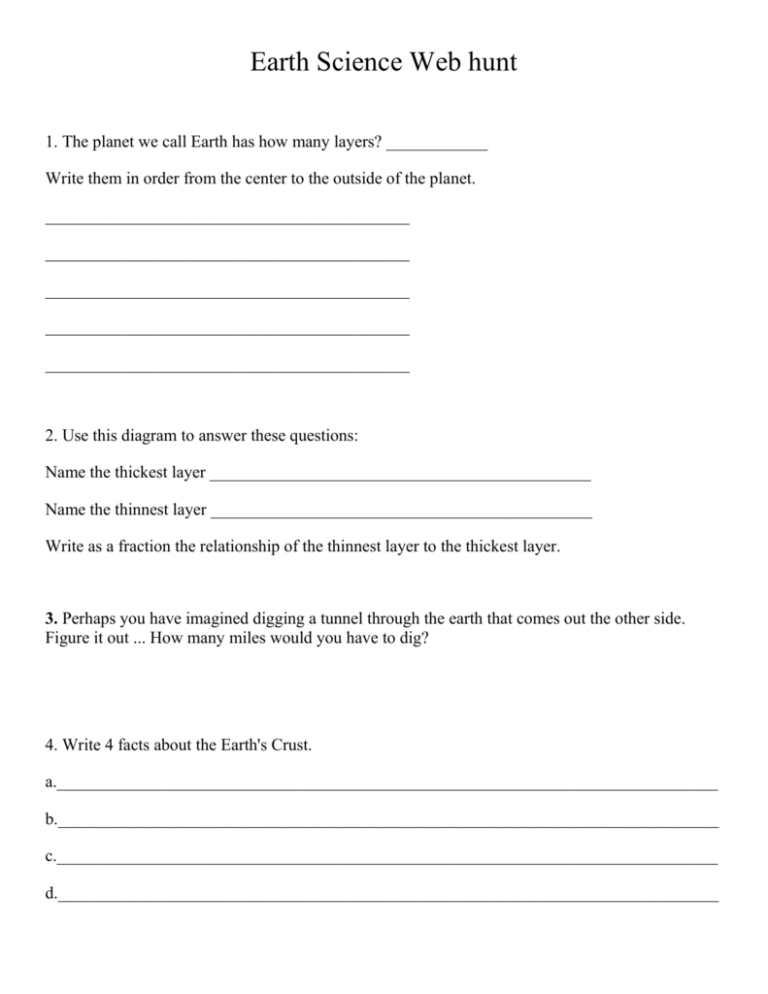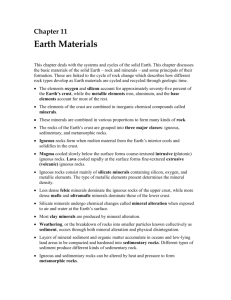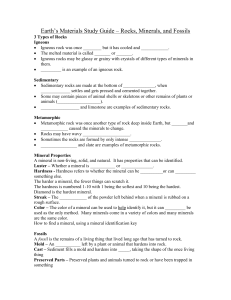Earth Science Web hunt
advertisement

Earth Science Web hunt 1. The planet we call Earth has how many layers? ____________ Write them in order from the center to the outside of the planet. ___________________________________________ ___________________________________________ ___________________________________________ ___________________________________________ ___________________________________________ 2. Use this diagram to answer these questions: Name the thickest layer _____________________________________________ Name the thinnest layer _____________________________________________ Write as a fraction the relationship of the thinnest layer to the thickest layer. 3. Perhaps you have imagined digging a tunnel through the earth that comes out the other side. Figure it out ... How many miles would you have to dig? 4. Write 4 facts about the Earth's Crust. a.______________________________________________________________________________ b.______________________________________________________________________________ c.______________________________________________________________________________ d.______________________________________________________________________________ 5. The crust and the upper layer of the mantle together make up a zone of rigid, brittle rock called the ______________________________________________________________________________ 6. Write three facts about the Mantle. a.______________________________________________________________________________ b.______________________________________________________________________________ c.______________________________________________________________________________ 7. What are the Convection Currents? ________________________________________________________________________________ ________________________________________________________________________________ ________________________________________________________________________________ ________________________________________________________________________________ 8. Name two metals found in the Outer Core. ____________________________ _________________________ The border between the Outer core and the Inner Core is how many miles beneath the crust? 9. The Inner core is under so much pressure it does not move like a liquid, it___________________________________. Write the temperature of the center of the Earth. ______________________________________________ 10. A scientist who studies rocks is called a ____________________________________. What does a Geomorphologist study? ______________________________________________________________________________ 11. Where is the earths crust the thinnest? 12. List the three rock groups. 13. Name five tectonic plates, Click on the photo on the left. 14. List 3 minerals found in a house. Name the specific product where each is used. 15. What is the difference between a mineral and a rock? 16. The gem Corundum is called a sapphire unless it is colored red. What do they call red colored corundum? 17. When was the Hope Diamond discovered? 18. Asbestos is a mineral that people used to protect themselves from fire. Later they discovered it was dangerous. How is it dangerous? 19. Frank Mohs developed a scale to measure hardness of gemstones. What is the scale called? 20. What mineral has the least hardness according to the scale? What mineral has the greatest hardness? 21. How are sedimentary rocks formed? And name two sedimentary rocks. 22. How are igneous rocks formed? 23. Ever hear the phrase "it sank like a stone"? What stone can actually float? 24. Name the tests that scientists use to identify minerals. Explain two of them. 25. What is an unusual property of the mineral ulexite? 26. What causes sedimentary and igneous rocks to change? 27. Nicholaus Steno set down two geologic principles. What are they? A. B. 28. Give three examples of physical weathering. 29. Describe how specific gravity is used to identity minerals 30. Every day you eat minerals. Your folks don't plop a bowl of minerals down for breakfast. So how are you eating these minerals? Figure it out here by reading about boron. 31. What are the coldest & warmest temperatures ever recorded on earth? What is their difference or range? 32. The wind speed is 10 MPH & the temp. is -5° Fahrenheit. What is the wind chill? 33. Use the weather map service at AccuWeather to locate your regional radar report. (Zip code service) What are your observations? 34. I hear there is a polar air mass coming. Describe the air that a continental polar air mass would bring. 35. Meteorologists talk of dew points. What does a dew point tell you? 36. If you wanted to measure the air pressure what instrument would you use? What unit of measurement would you use? (Hint: look for more detail on the left) 37. Explain the effect snowfalls have on sound. 38. How wide is lightning? 39. Weather maps use a symbol called the wind barb. What does it show? 40. Become enlightened about lightning. List 3 safety rules that you would follow in lightning storm. 41. What is the probability there will be precipitation in your area tomorrow? Find out at the National Weather Service. 42. Why are raindrops different sizes? 43. What does water have to do with air temperature? 44. Why do clouds form? 45. Raindrops are shaped like teardrops. True or false, and draw one. 46. What is Global Warming? Which factors, that contribute to global warming, can people control? 47. The bus is running late this October morning due to the fog. Why is there more fog in the autumn? 48. Name mineral that is red 49. Check out the Weather on top of Mt. Washington, NH. They are reported to have some of the worst weather on earth! What do you observe? 50. How does FEMA help you, your family, & your community deal with weather disasters? 51. What is weather ? 52. What causes weather ? 53. What is the difference between weather and climate? 54. Name the 4 essential components of weather forecasting. 55. What is a barometer ? 56. How are clouds formed? 57. Sketch 4 ways in which clouds are formed 58. Name the 10 main cloud types 59. Geologists classify rocks into three groups, according to the major Earth processes that formed them. The three groups are: 60. Igneous rocks, also called volcanic rocks, are formed how? 61. List 10 igneous rocks 62. Common sedimentary rocks include: 63. Minerals are classified according to chemical composition. There are seven major chemical groups: List them. 64. Minerals that are composed of atoms of a single element are referred to as. 65. The minerals that make up the______________ class include those in which oxygen is combined with one or more metals. 66. The silicate mineral class is considered to be the most important of all the mineral classes. About 25% of the known minerals and nearly 40% of the common ones are silicates. Nearly________ % of the igneous rock-forming minerals are silicates, which means that they make up over 90% of the _____________. 67. Describe the rock cycle here, draw it if you like. 68. What characteristics or properties are used to identify and describe minerals? Write about the meaning of each: color streak fracture hardness luster crystal systems taste specific gravity magnetism chatoyancy odor fluorescence






